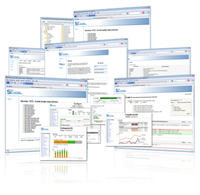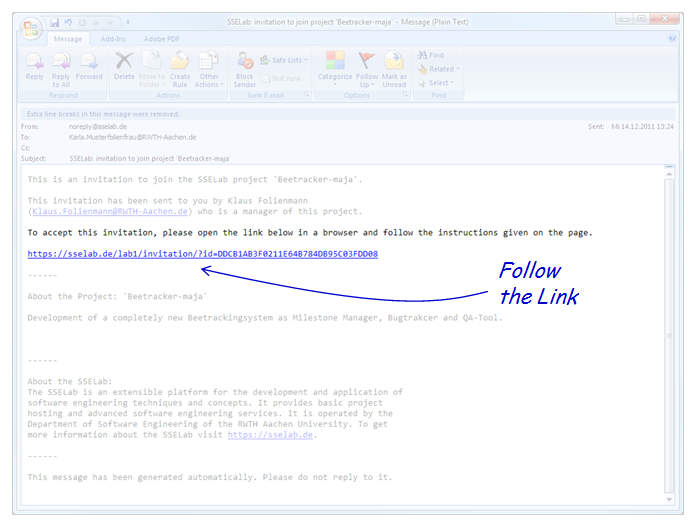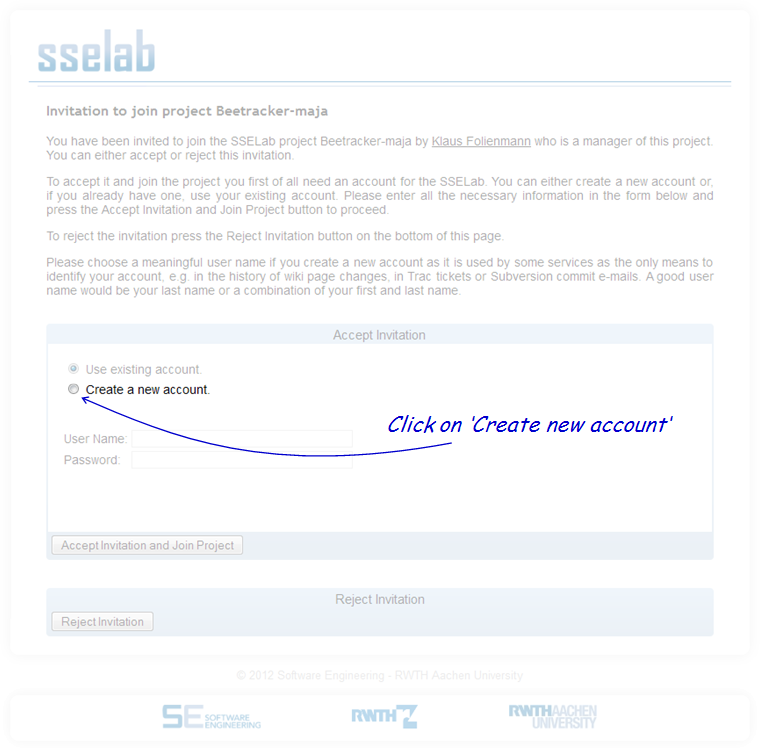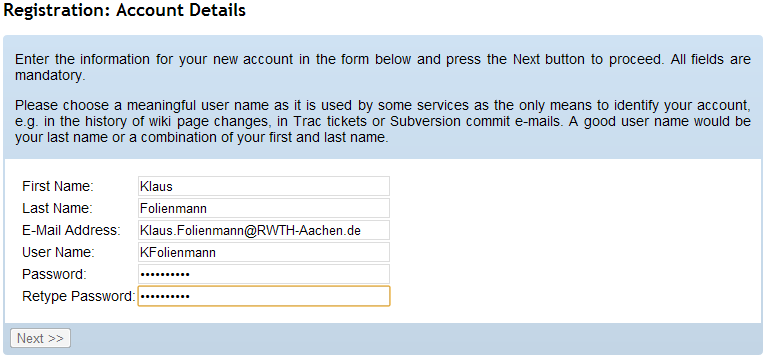
Simple start
From sselab
You have been invited to the sselab and you have no idea what this means?
You probably shall share some documents within a team and come to an integrated final document easily (--> version control) or shall collect thoughts, ideas, problems etc.(--> wiki).
Simple storage like Dropbox (--> storage) is also available as well as a automatically generated mailing list (--> mailing list). Let's forget about all the other services for now and lets handle this:
- You need to make an account.
(Having an account simplifies access when using multiple projects. All services and projects can be accessed and managed with one account and password.)
- You got an invitation via email. Click the link in that email.
- Choose 'Create new Account' if you don't have one yet.
- Enter some personal data, it is really helpful to use your surname as login (or another name that identifies you to the other team members).
- You now have the account and are member of the project.
- This allows you to login to sselab and browse the project data.
Contents |
What's next?
You can
- Browse the projects services
- Checkout svn (if it is a selected service)
- Look at the internal and external wikis (if selected services)
- Note that the external wiki is globally visible, while only you can write
- Install the webdav (if selected service)
- Look at the mailinglist
- BTW: When the project is called "example", the according maillinglist where you can reach all other members is "example@lab9.sselab.de"
Mailing List
You want to send an email to all project members (and managers)?
- Click on 'Mailing List' on the project's overview page in the services List
If you have a standard email program an empty new email to all members of the project will open. If you haven't, just copy the email adress, open an email and paste the adress into the adress field.
Wikis
Its simple:
- browse the project,
- click on "MediaWiki (internal)"
- and you are looking at the wiki. Its a mediawiki -- same syntax, same features.
This is just an abstrct overview -- see [http:/XXX here for more]:
- To edit full page: click "Edit" on the left side
- To edit a section: click "[edit]" on the right side
- When the page is important and you want to be informed by email of any change: click "Watch"
Some syntax:
bold text - '''bold text'''
italic text - ''italic text''
- list element - * list element
- list element - * list element
- numbered list element - # numbered list element
- numbered list element - # numbered list element
- numbered list element - # numbered list element
File:Example.jpg - [[File:Example.jpg]]
By clicking on the new link you open the file upload dialog. Just try it, when you need to insert a picture. You will see, it is very easy.
link title - [http://www.example.com link title]
An Hyperlink to the specified url (here 'http://www.example.com' which appears to the reader of the wiki article as 'link title' ).
Headline 2
== Headline 2 ==
Headline 1
= Headline 1 =
This sections your articles. An edit button will appear on top of each section for the members of the project.
Version Control (Subversion)
Subversion is a relatively mighty and therefore also complex technique to concurrently work on files. When people really work on shared files concurrently, it's important to have versioning available: subversion does this! And to manage conflicts in concurrent changes: subversion does this too! (When a conflict arises or you want an older version you need a deeper understanding or have to ask. E..g. have a look here. For simple cases:
- You need to install a local subversion client. You may choose. XXX is quite good, but Eclipse plugin also helps.
- Please install your svn-client
- Checkout the files using the name and password of your sselab-account.
- Then you are ready to operate.
As an alternative for read only access:
- browse the project,
- click on "Subversion"
- and you have webaccess to the current(!) revision (!no changes!).






